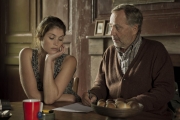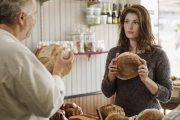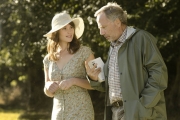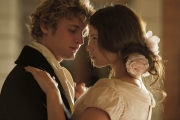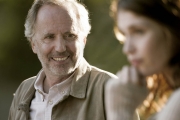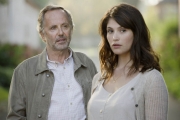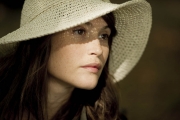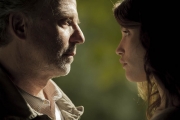Martin is a former Parisian Yuppie, more or less willingly converted into a baker in a Normandy village. All that remains of his youthful ambitions is a lively imagination and a passion for great literature, for Gustave Flaubert in particular. One can easily imagine his excitement when an English couple with bizarrely familiar names moves into a small farm nearby. Not only are the names of the new arrivals Gemma and Charles Bovery, but their behaviors also seem to be inspired by Flaubert’s heroes. For the creator lying dormant in Martin, what an opportunity to knead not only his daily dough, but the fates of flesh and blood characters too! But the beautiful Gemma Bovery has not read the classics, and intends on living her own life…
Cast & Crew
Director • Anne Fontaine
Screenwriters • Anne Fontaine, Pascal Bonitzer
Based on the novel by Posy Simmonds
Producer • Philippe Carcassonne, Matthieu Tarot
Starring :
Gemma Arterton, Fabrice Luchini, Jason Flemyng, Isabelle Candelier, Nils Schneider…
Choose a picture to see the filmography (source : IMDB)
![]()
How did you discover Posy Simmonds’ comic strips?
I knew Posy Simmonds through Tamara Drewe, and I felt an immediate a priori preference for the novel called Gemma Bovery: the wordplay on a distorted feminine literary archetype seemed promising and amusing. When I read the novel, the characters intrigued and touched me: I felt their comedic potential and their profound humanity, and I was seduced by the author’s tone, between fierce comedy and powerful irony. I was also sensitive to the improbable encounter between a baker and this young modern English woman. She will alter the life of the protagonist, who, convinced of having his libido under control, was seeing himself as in an early sexual and emotional retirement! And here he goes spinning out of control between a fictional character –Emma Bovary—and Gemma Bovery. This fetishist approach was extremely seductive for a film scenario. I tried to stay loyal to the book, while taking liberties: in Posy Simmonds’ work, Joubert, the narrator, intervenes somewhat indirectly in the story, while in the film, we gave him an actual body and more mobility.
You would think that Martin’s character was custom made for Fabrice Luchini…
And yet he was imagined by an English woman! But when I read the graphic novel, I immediately saw Fabrice Luchini, not only as an actor, but as someone with Flaubert in his blood, deep inside of him. Given that I knew him well, and that I had so often heard him speak of Madame Bovary in a personified manner, I had the feeling that this role was meant for him. So I wrote the plot, telling myself that there was a pretty strong possibility that he would like the character, and that he would be touched like me by this literary obsession, leading to the calm life of a baker until this wild encounter transforms his own reality. It was amazing to have such an actor as Fabrice because he has such a sense of fantasy and disconnectedness, but also the pleasure and the love for words –which corresponds to the film’s subject itself. I was very lucky to have such an actor because only Fabrice could recreate this obsession with Madame Bovary as something completely natural. The process of the protagonist’s personification –and also his madness—solidifies as soon as he pronounces, in his unique way, “Gemma Bovery.” It was all the more important that he is a character who observes others’ lives through a window, a voyeur who creates stories. Since I found that the character was similar to a film director, there was a strong, underlying link between us.
How do you direct him?
With him, I experiment, and always in a playful way. We look for tonalities, we go too far in one direction, we do multiple tries, and then we go back to the beginning: we must find the exact tone by asking ourselves how far we can go. I never restrict him within a constraining frame: so we film nine or ten takes, and then I tell him, “Now, forget what I said, and do what you want.” But what counts above all is the absolute trust that prevails between us.
Did you think of Gemma Arterton after having seen Tamara Drewe?
I had seen Gemma Arterton in Tamara Drewe and in a certain way, I told myself that since she had already played one of Posy Simmonds’ characters, this would not interest her. So I went looking for English actresses with an objective in mind: they would need to be sexy and speak French. But none of the actresses I met seemed right for the part. Finally, I met Gemma, and as soon as she opened the door and she read me a little excerpt in French that she had written, I knew that I was dealing with an atomic bomb: she gave off such energy that no one could help but love her. She has a warm and generous beauty that does not keep you at a distance, so that her hesitations and her “back and forth” are more accountable to her youth and her freshness, rather than manipulation. I did not even need to test her out: she came to France for three months to immerse herself in the local culture before working on the character. To prevent her acting to appear too contrived when speaking French –which is a risk for actors learning a foreign language—, I asked her to move constantly and to be in the action. As a result, she came extremely prepared to the set, telling me that she felt the character very close to her.
This is the second time that you worked with Anne Fontaine.
And every time she confronts me with stunning creatures: Louise Bourgoin in La Fille de Monaco, and the extraordinary Gemma Arterton in this film. Anne is a very original filmmaker, she never falls in societal pathos. For me, because of the freedom that she allowed on the set, her willingness not to control, Gemma Bovery is her best film.
What was your first reaction to the plot of Gemma Bovery?
I loved its originality. The point was not to provide an illustration of Flaubert’s Madame Bovary, but to multiply the “back and forth” between the novel and the contemporary fiction. To smuggle Flaubert in, like for Molière in Alceste à bicyclette. It is the same approach: we go looking for texts and we give them back another life. Anne Fontaine –and in a way Posy Simmonds in her work—had the genius not to confront Flaubert upfront. She took the complete opposite stand of Claude Chabrol’s film adaptation.
How did you prepare Martin’s character?
Anne Fontaine wanted me to intern at a bakery. I thought: “Am I in a Stanislavski’s acting class? She is going to have to find another actor, because I will not spend fifteen days watching some guy making bread!” Anne came to her senses. An expert in horses with whom I had dealt on the filming of Perceval le Gallois, by Eric Rohmer, told me one day: “The big thing about horses is that as soon as they meet the person who is going to ride them, they know whether or not they are dealing with a good horseman. If it is a bad one, they determine the exact moment when they will make them fall. But Gérard Philippe was such a great actor that he could make the horses believe that he was a good horseman.” Modestly, I was able to make people believe that I was a good baker.
Gemma Arterton literally shines in the role of Gemma.
This girl is sublime, she is an exceptional actress. She has this perfection and this genius that possesses Anglo-Saxon actors. For two months, we barely spoke, yet she understood well who I was. As soon as we heard “Moteur”, we were like two unwitting people who understood, loved and respected each other.
What drew you to this project?
I must say that when I received the scenario, I was reluctant to accept to participate in this project because I had already played in Tamara Drewe, another Posy Simmonds’ adaptation. The tone was similar, but the protagonist was very different and there was something about her that seduced me more: I recognized myself more in Gemma than in Tamara. Additionally, the story unfolded in France, and I was interested in the prospect of learning French. Without forgetting that Anne Fontaine is a director of great sensitivity and that I really wanted to work under her direction.
Did Flaubert’s heroine, Emma Bovary, help you to better grasp your character?
Absolutely. This allowed me to grasp the identity of the character –the idleness—because Madame Bovary does not have much to do in her life and Gemma is a modern Madame Bovary. What helped me too were the landscapes, the society and the traditions depicted in the book, which can still be found in Normandy nowadays. This corresponds to the English romantic idea of Normandy, and it is exactly in this state of mind that Gemma and Charles set off in this region.
How did you prepare for this role?
Since I had to learn French, I moved to Paris a few months before the start of filming: I freaked out because I did not speak a word of the language! As a result, I immersed myself a little in the local culture, and I remember that Anne said to me over and over: “You are just like the character!” In a certain way, she was right: I was like Gemma because she was supposed to be placed in a culture that was not her own, feeling like a foreigner. Next, I went to Brittany for a few weeks to perfect my French. I also went out with French people, I went to concerts with them, etc. and that was in itself a form of preparation.
This is the first time that you have filmed with a French team…
I loved this experience because there is an immense respect for cinema here. All the technicians excelled in their own fields, and our director of photography was astounding. For everyone, the most important thing consisted in telling the story as best as possible.
Press Kit “Gemma Bovery”
French ~ 20 pages ~ 3,5 Mo ~ pdf



